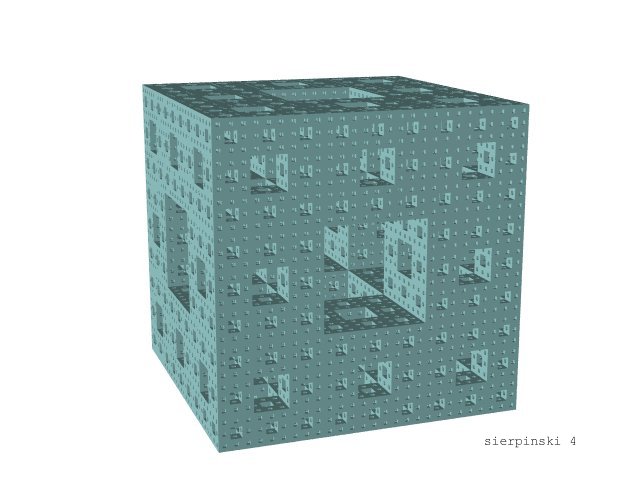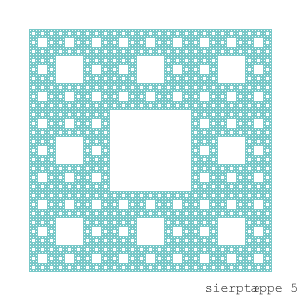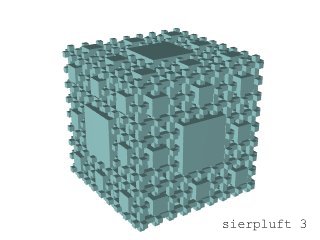|
The Sierpinski Sponge |
|
The Sierpinski Sponge |

The Sierpinski Sponge is a fractal. Small parts look like big parts, that look like even bigger parts.
It is build by repeatedly glueing 20 smaller Sierpinski Sponges together like this:

Written properly, in the mathematical way, the Sierpinski Sponge can be defined like this:
|
sierpinski 0
= cube where "cube" has the corners (±1,±1,±1) sierpinski n = (move (+2/3,+2/3,+2/3) )º(mul 1/3) (sierpinski n-1) ∪ (move ( 0 ,+2/3,+2/3) )º(mul 1/3) (sierpinski n-1) ∪ (move (-2/3,+2/3,+2/3) )º(mul 1/3) (sierpinski n-1) ∪ (move (+2/3, 0 ,+2/3) )º(mul 1/3) (sierpinski n-1) ∪ (move (-2/3, 0 ,+2/3) )º(mul 1/3) (sierpinski n-1) ∪ (move (+2/3,-2/3,+2/3) )º(mul 1/3) (sierpinski n-1) ∪ (move ( 0 ,-2/3,+2/3) )º(mul 1/3) (sierpinski n-1) ∪ (move (-2/3,-2/3,+2/3) )º(mul 1/3) (sierpinski n-1) ∪ (move (+2/3,+2/3, 0 ) )º(mul 1/3) (sierpinski n-1) ∪ (move (-2/3,+2/3, 0 ) )º(mul 1/3) (sierpinski n-1) ∪ (move (+2/3,-2/3, 0 ) )º(mul 1/3) (sierpinski n-1) ∪ (move (-2/3,-2/3, 0 ) )º(mul 1/3) (sierpinski n-1) ∪ (move (+2/3,+2/3,-2/3) )º(mul 1/3) (sierpinski n-1) ∪ (move ( 0 ,+2/3,-2/3) )º(mul 1/3) (sierpinski n-1) ∪ (move (-2/3,+2/3,-2/3) )º(mul 1/3) (sierpinski n-1) ∪ (move (+2/3, 0 ,-2/3) )º(mul 1/3) (sierpinski n-1) ∪ (move (-2/3, 0 ,-2/3) )º(mul 1/3) (sierpinski n-1) ∪ (move (+2/3,-2/3,-2/3) )º(mul 1/3) (sierpinski n-1) ∪ (move ( 0 ,-2/3,-2/3) )º(mul 1/3) (sierpinski n-1) ∪ (move (-2/3,-2/3,-2/3) )º(mul 1/3) (sierpinski n-1) |
When you say the Sierpinski Sponge, you are really refering to "sierpinski ∞". Unfortunately it is not really possible to draw this, but "sierpinski 4" gives a good impression of what it must look like.
There is a 2-dimensional version of the Sierpinski Sponge, called the Sierpinski Carpet.

The Sierpinski Carpet is the "footprint" that the Sierpinski Sponge makes. It can be constructed by repeatedly glueing 8 smaller Sierpinski Carpets together.
It is possible to calculate the area (A) and perimeter (P) of the Sierpinski Carpet.
A 0 = 22 = 4
A n = 8·(1/3)2·(A n-1) = (8/9)·(A n-1)
It says that "sierpcarpet 0" has area 4, and that the area of "sierpcarpet n" (A n) is the same as all the (8) small ((1/3)2) Sierpinski Carpets area (A n-1). From this you can derive that:
A n = (8/9)n·4
The perimeter is found in a similar way:
P 0 = 4·2 = 8
P n = 8·(1/3)·(P n-1) - 8·(1/3)·2·2
= (8/3)·(P n-1) - (32/3)
The perimeter (P n) is the same as all the (8) small (1/3) Sierpinski Carpets perimeters (P n-1), apart from the length of all the (8) small (1/3) sides (2) where they meet, and they are two (2) sides meeting. From this you can likewise derive that:
P n = (8/5)·(8/3)n + (32/5)

You can calculate the volume (V) and area (A) for the Sierpinski Sponge. It is done in the same way as for the Sierpinski Carpet. I omit comments, and write only the hard facts...
V 0 = 23 = 8
V n = 20·(1/3)3·(V n-1)
which gives
V n = (20/27)n·8
and
A 0 = 6·22 = 24
A n = 20·(1/3)2·(A n-1) - 24·(1/3)2·(At n-1)·2
= (20/9)·(A n-1) - (64/3)·(8/9)n-1
(At is the Sierpinski Carpet's area)
which gives
A n = (8/9)n·16 + (20/9)n·8
What influence does this have for the Sierpinski Sponge, "sierpinski ∞"? Well, as n → ∞, so will V n → 0, while A n → ∞. Stated a bit simplistically "sierpinski ∞" doesn't have any volume, but has an infinite surface area!
The part you have to cut out of a solid cube to get a Sierpinski Sponge, looks like this:

While the Sierpinski Sponge has a volume of 0, the Sierpinski Luft has a volume of 8 (when n → ∞). The surface area of the Sierpinski Luft → ∞, just like that of the Sierpinski Sponge.
|
http://www.h33.dk/sierpinski_index.en.html
last changed 27.mar.2005 © 1997-2005 Bjørn Hee, mailto:webmaster@h33.dk |